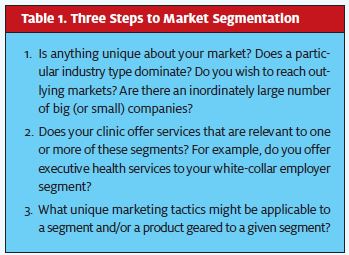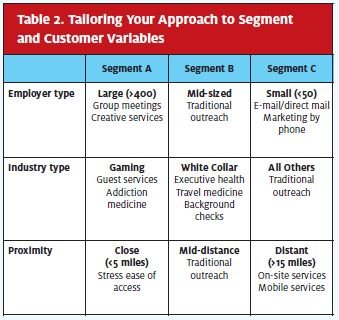If you have more than one child or grew up with at least one sibling, you have probably experienced “segmentation.” That is, you have most likely used different tactics and strategies in dealing with each of your children or you were treated somewhat differently than your siblings.
Segmentation within the urgent care occupational health market follows the same principle; a communication technique that is effective with one audience may not work as well with another.
Market Differentiation
 Any clinic launching a marketing campaign should explore the question of whether its market has different segments that require different sales and marketing strategies. Usually, the answer is “Yes.”
Any clinic launching a marketing campaign should explore the question of whether its market has different segments that require different sales and marketing strategies. Usually, the answer is “Yes.”
Consider a national political campaign: A candidate’s core message in California is likely to be considerably different than the message he would emphasize in Georgia or Iowa.
Market segments for an occupational health initiative are limited only by one’s imagination and are likely to vary by region. However, three variables are virtually universal in occupational health: employer size, industry type, and proximity (i.e., distance from your core delivery locale).
Employer Size
A clinic’s basic instinct is to market to mid-sized employers. However, such an emphasis ignores the largest and smaller employers in a market, thus ceding volume potential to competitors. A more fruitful strategy is to market continually to all segments: large, mid-sized, and small. Each of these segments requires different stimuli in order for your clinic to be most effective with each group.
Large employers tend to be low-probability/high-reward prospects. Breakthroughs with large employers are more likely to occur when a team, including physicians and/or clinic managers, is periodically involved in the sales process. For example, your clinic might schedule a weekly group sales call at a set day/hour that is devoted to “large employers.” With such a commitment, your urgent care clinic will cultivate approximately 50 large employers a year.
Small employers are largely overlooked as well, although in the aggregate they can produce significant volumes for an occupational health program. When it comes to marketing to smaller employers, emphasize multiple contacts through various modalities (e-mail, voice mail, letters) that reiterate a constant message and continually reinforce your clinic’s name.
How does a clinic define a large, medium, or small employer prospect? It depends on the market. The definition of employer size will vary markedly from Chicago, where a “large” employer might have more than 1,000 employees to Cullman, Alabama, where a large employer might be defined as any company with more than 50 employees.

Industry Type
Some markets may be perfectly heterogeneous, with an employer mix that reflects American industry as a whole. Others may have prominent niches, such as Las Vegas, resort communities, and/or markets with an agricultural or white-collar emphasis. Should a unique employer segment be identified, your clinic must determine specific out- reach tactics and/or appropriate product niches.
Proximity
Different strategies and an emphasis on different products may apply to employers based at various distances from your urgent care clinic(s).
Your clinic should showcase its convenience, for example, to employers most proximate to your locale. Alternatively, a clinic can emphasize possible on-site and mobile services to employers located at the periphery of your market area.
The Chicago-Cullman continuum applies to this segment as well: a “distant employer” in Chicago may be simply more than a 15-minute drive away, while those in Cullman might be 30 or more miles away from the clinic.
